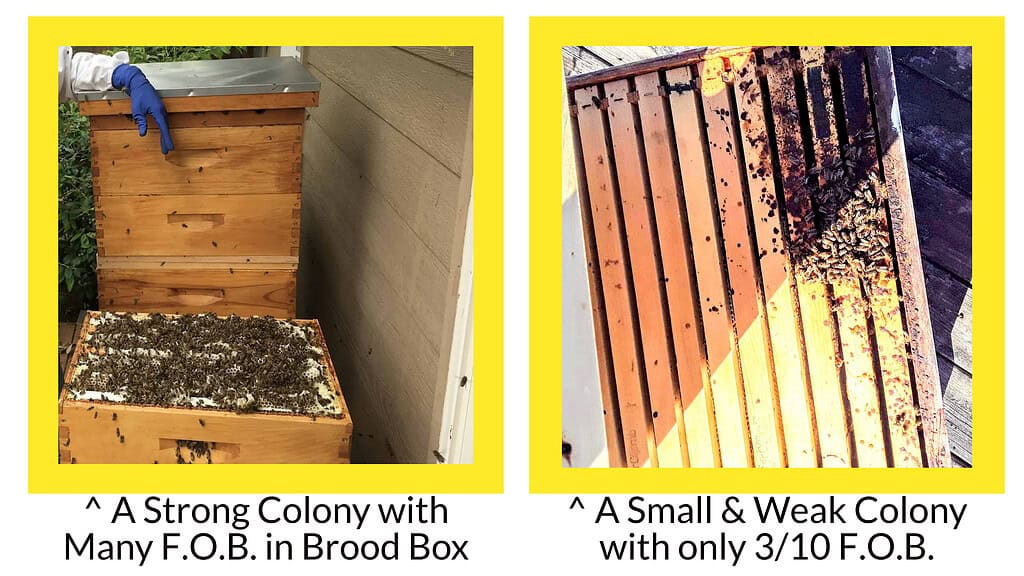Assessing the size of a honeybee colony is crucial for maintaining hive health and ensuring optimal productivity. Regular colony assessments can reveal early signs of potential problems, allowing beekeepers to take proactive measures to support the hive. During these assessments, using the best beekeeping suits and beekeeping jackets provides essential protection, allowing beekeepers to inspect hives closely and safely. This article will explore how to assess honeybee colony size effectively and discuss why maintaining an ideal bee population is vital for a healthy, thriving hive.
Page Contents
1. The Importance of a Healthy Honeybee Colony Size
For any beekeeper, understanding the optimal hive size for honeybees is a foundational aspect of hive management. Colony size directly impacts everything from honey production to pollination effectiveness, and it even influences the colony’s survival during winter.
Healthy colony size helps the bees efficiently allocate resources and maintain strong colony defense mechanisms. Hives with a balanced bee population are better equipped to resist diseases, pests, and environmental changes. Therefore, assessing and managing honeybee colony health is key to creating a sustainable environment where bees can flourish.
2. Key Indicators of Honeybee Colony Size
To assess the honeybee colony size, look for several physical indicators within the hive:
- Frame Coverage: Observe how many frames are covered with bees. Healthy colonies typically cover several frames. If frames are heavily populated with bees, this usually signifies a strong colony.
- Brood Pattern: A consistent brood pattern, with few gaps, indicates a productive queen and a balanced colony size.
- Foraging Activity: Regular foraging activity during good weather is a positive sign of an engaged and active colony.
Understanding these signs of a healthy honeybee colony provides beekeepers with essential insights into the hive’s status. Observing these aspects regularly can also help identify trends and seasonal shifts in colony population.
3. Tools and Techniques for Beekeeping Colony Size Assessment
Assessing honeybee colony size doesn’t always require complex tools. Here are a few effective methods used by beekeepers for accurate colony size assessment:
- Visual Inspection: This involves physically observing the hive. Estimate the population based on how many frames are covered by bees and the layout of brood, honey, and pollen.
- Hive Scales: Hive scales allow beekeepers to monitor colony size changes over time by tracking hive weight. Weight fluctuations often correlate with population changes, especially during honey flows or seasonal transitions.
- Digital Monitoring Systems: Advanced technology like digital sensors tracks temperature, humidity, and bee activity, giving more detailed insights into colony health and size.
When used consistently, these tools aid in colony growth monitoring without disturbing the bees, helping beekeepers track population trends and anticipate colony needs.
4. Ideal Bee Population for a Healthy Hive
Ideal bee population varies based on season and hive type, but maintaining a balanced population is essential. A healthy colony in peak season may include up to 50,000 bees, with an ample number of worker bees, a few drones, and a single queen.
- Signs of Overpopulation: A crowded hive can lead to swarming, where part of the colony leaves to establish a new hive. Overpopulation increases stress on resources and can compromise hive health.
- Underpopulation Risks: A sparse bee population reduces the hive’s productivity, weakens its defense, and impairs temperature regulation, which can harm brood development.
By regularly assessing colony size, beekeepers can help maintain an ideal population by taking measures like merging hives, splitting colonies, or adding new brood frames.
5. Seasonal Variations in Honeybee Colony Size
Seasonal changes naturally affect beehive population dynamics. Here’s a breakdown of what to expect during different times of the year and how to prepare:
- Spring: The colony is in a growth phase, with increasing brood and foraging activity. Beekeepers should monitor for signs of swarming and prepare for any necessary hive expansion.
- Summer: Peak season with high brood production and honey gathering. A larger bee population is beneficial during this period, but be vigilant about signs of overcrowding.
- Autumn: Colony size begins to shrink as brood rearing declines. It’s crucial to ensure that the hive has adequate food stores for winter.
- Winter: The colony reduces to a minimal size to conserve energy. Beekeepers should focus on insulation, feeding, and maintaining an appropriate environment to help the bees survive the season.
Regular monitoring allows for colony growth monitoring and helps beekeepers stay prepared for seasonal population fluctuations, which are crucial for maintaining honeybee colony health year-round.
6. How to Adjust for Optimal Colony Size
Sometimes, natural colony dynamics may require beekeepers to step in and make adjustments to optimize beehive population dynamics:
- Merging Hives: If a colony is too small, merging it with another hive can strengthen the population and make it more resilient.
- Splitting Colonies: A very large colony is more prone to swarming, so splitting it into two separate hives can reduce crowding and stress.
- Supplemental Brood Frames: Adding frames with brood to a weaker hive can help bolster population size and support colony stability.
Proper colony size assessment helps beekeepers determine which of these methods might be necessary, ensuring that the hive remains balanced and productive.
7. Conclusion
Routine assessment of honeybee colony size is a proactive step toward sustaining hive health and productivity. By regularly observing key indicators, using effective monitoring tools, and understanding seasonal changes, beekeepers can create an environment where bees can thrive. Equipping yourself with the best beekeeping gear, such as high-quality bee suits, durable gloves, and reliable hive tools, ensures both safety and efficiency during assessments, enabling close inspections without disturbing the bees.
Regular colony size assessments help in identifying and addressing issues before they become serious. With a balanced population, the colony can efficiently defend itself, maintain productivity, and adapt to environmental shifts. Ensuring a healthy honeybee colony isn’t just about honey production—it’s about fostering a resilient and robust hive capable of surviving for many seasons to come.


